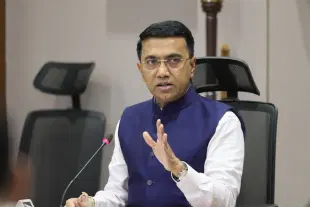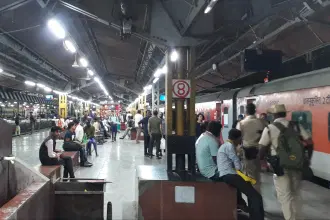News Brief
Goa To Rebuild Temple Destroyed By Portuguese At Historic Location On Divar Island, CM Sawant Announces
Nishtha Anushree
Sep 11, 2025, 11:06 AM | Updated 11:06 AM IST
Save & read from anywhere!
Bookmark stories for easy access on any device or the Swarajya app.


On Wednesday (10 September), Goa Chief Minister (CM) Pramod Sawant announced that the state Cabinet has approved the creation of a 'Koti Tirth corridor,' which will feature the reconstruction of the Saptakoteshwar temple, originally demolished under Portuguese colonial rule, at its historic location on Divar island.
Describing the decision as a significant milestone and a homage to the "plight of deity and the sacred site destroyed during the colonial era," Sawant noted that around 1,000 temples across Goa were razed by the Portuguese invaders. He explained that this initiative aligns with the administration's broader commitment to reviving such religious landmarks.
“The corridor at Divar will be a devoted space that preserves the memory of Goa’s temples…once destroyed and lost in history…as a lasting tribute to faith and heritage,” he said
The CM revealed that a senior-level panel, led by the archaeology secretary, has been established to manage the planning, implementation, and supervision of the corridor's development. The project will be handled by the Goa Infrastructure Development Corporation.
“After the original temple was destroyed, Chhatrapati Shivaji Maharaj had constructed the Saptakoteshwar temple in Narve [Bicholim]. However, a temple was not rebuilt at the old site,” Sawant informed reporters following the Cabinet session.
“It was everyone’s opinion that if so many temples were demolished…this kind of a corridor will be established and a big temple will be built on 10,000 square metres of land by the government so that we have a memorial where people can worship,” Sawant said.
The Journey of Temple
Historical accounts indicate that the Saptakoteshwar temple site at Naroa on Divar dates back to the Kadamba era (10th to 14th century), with its rock-cut tank known as 'Koti-Tirth.' The structure was first demolished during the Bahmani sultanate and later restored in 1391 by a Vijayanagar kingdom official.
In the 16th century, the Portuguese forces destroyed it again, prompting the relocation of the deity's idol to Bicholim, where Shivaji founded a replacement temple in 1668.
In January 2023, the Goa administration set up a specialised group to evaluate proposals for rebuilding and preserving temples lost during the Portuguese period, allocating Rs 20 crore in the budget for these efforts.
Nishtha Anushree is Senior Sub-editor at Swarajya. She tweets at @nishthaanushree.





